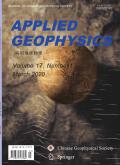Dispersion characteristics of seabed Scholte waves with variable velocity seawater in deep water
Abstract
Acoustic velocity varies in deep-water environments. To obtain accurate inversion interpretations, it is necessary to develop a horizontally layered seawater—seabed (HLSS) model with continuously varying velocities. In this work, we used an HLSS model based on wave theory to deduce the Scholte wave dispersion equations and established an HLSS model based on the acoustic velocity profile and the submarine medium parameters of the South China Sea. We studied the dispersion characteristics of Scholte waves and theoretically calculated the amplitude—depth distribution. We also examined the influence of deep-water environments on the dispersion characteristics of Scholte waves. Using the real geological parameters of the Dongsha Islands in the South China Sea, we exploited the spectral element method to simulate seismic wave propagation in the fluid—solid interface and extracted the Scholte wave dispersion curves using multichannel analysis of surface waves (MASW). The consistent theoretical and extracted dispersion curve results verified the accuracy of our method. Numerical experiments showed that the dispersion characteristics of Scholte waves in deep water are weaker than those in shallow water. In addition to the seawater depth and the physical parameters of seabed sediments, the seawater’s variable velocity also influences Scholte wave dispersion characteristics.

 求助内容:
求助内容: 应助结果提醒方式:
应助结果提醒方式:


